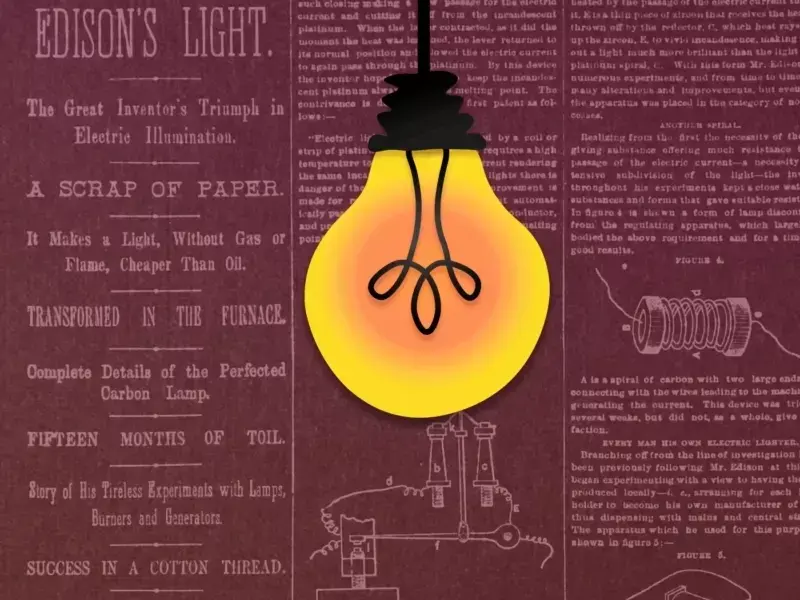Journalism
San Francisco Names a Street For the Photographer Who Captured Marines Raising an American Flag at Iwo Jima
Joe Rosenthal is famous for his Pulitzer Prize-winning image. But he spent most of his career photographing San Francisco, where he lived for many years
When Instant Replay Debuted During the Broadcast of a College Football Game in 1963, It Revolutionized the Way We Watch Sports
Piloting the new technology was a risky move in front of the national audience that watched the Army-Navy showdown on this day in 1963
When Republicans Became 'Red' and Democrats Became 'Blue'
The 2000 presidential election cemented the color-coded nature of political parties. Prior to that race, the colors were often reversed on electoral maps
The Real Story Behind the 'Lee' Movie and Lee Miller, the Legendary Surrealist Photographer and World War II Journalist Who Inspired It
In a new biopic starring Kate Winslet, Miller's many lives—as an artist, model, muse, cook and war correspondent—need little embellishment
Why the Debut Issue of America's First Newspaper Was Also the Publication's Last
On this day in 1690, "Publick Occurrences Both Forreign and Domestick" attracted colonial officials' ire by repeating a scandalous rumor and condemning a British alliance with the Mohawk
This Defeated Presidential Candidate, Once the 'Best-Known Man in America,' Died in a Sanatorium Less Than a Month After Losing the Election
Newspaper editor Horace Greeley unsuccessfully ran against incumbent Ulysses S. Grant in November 1872. Twenty-four days later, he died of unknown causes at a private mental health facility
The Real Story Behind the Baltimore Deaths That Inspired 'Lady in the Lake'
A new mini-series offers a fictionalized take on two unrelated 1969 cases: the mysterious disappearance of bartender Shirley Lee Parker and the murder of 11-year-old Esther Lebowitz
How the Rise of the Camera Launched a Fight to Protect Gilded Age Americans' Privacy
Early photographers sold their snapshots to advertisers, who reused the individuals' likenesses without their permission
'The Crime of the Century,' a Century Later
In the summer of 1924, the Leopold and Loeb murder case triggered a media frenzy and a debate over whether anyone can truly know what’s inside the mind of a cold-blooded killer
Who Was 'Lisa Ben,' the Woman Behind the U.S.'s First Lesbian Magazine?
Edythe Eyde published nine issues of "Vice Versa" between June 1947 and February 1948. She later adopted a pen name that doubled as an anagram for "lesbian"
Martha Gellhorn Was The Only Woman to Report on the D-Day Landings From the Ground
In June 1944, the veteran journalist hid on a hospital ship so she could report firsthand as Allied soldiers fought their way onto the beaches of Normandy
How the Murder of a Black Grocery Store Owner and His Colleagues Galvanized Ida B. Wells' Anti-Lynching Crusade
The saga of People's Grocery stands as a powerful reminder of the centrality of Black radicalism to the food justice movement
Why Leopold and Loeb Committed Cold-Blooded Murder in the 'Crime of the Century'
A century ago, two Chicago teenagers killed an acquaintance named Bobby Franks for the thrill of it. The case captivated the nation and continues to fascinate the public today
This 12-Year-Old Boy Fought on a World War II Battleship and Became the Nation's Youngest Decorated War Hero
In 1942, young Calvin Graham was decorated for valor in battle, before his worried mother learned of his whereabouts and revealed his secret to the Navy
World War II 'Rumor Clinics' Helped America Battle Wild Gossip
Newspapers and magazines across the United States published weekly columns debunking lurid claims that were detrimental to the war effort
After Winning the Battle of Gettysburg, George Meade Fought With—and Lost to—the Press
The Civil War general's reputation was shaped by partisan politics, editorial whims and his own personal failings
How Thomas Edison Tricked the Press Into Believing He'd Invented the Light Bulb
A year before he developed a working bulb, the "Wizard of Menlo Park" created the illusion that his prototype burned for more than a few minutes at a time
The Photographer Who Forced the U.S. to Confront Its Child Labor Problem
Lewis Hine's early 20th-century "photo stories" sparked meaningful legislative reform
Martin Luther King Jr. Never Said Famous Quote Criticizing Malcolm X
One journalist's archival discovery is changing historians' understanding of the two civil rights leaders
How Josephine Herbst, 'Leading Lady' of the Left, Chronicled the Rise of Fascism
During the interwar years, the American journalist reported on political unrest in Cuba, Germany and Spain
Page 1 of 11
:focal(1407x1058:1408x1059)/https://tf-cmsv2-smithsonianmag-media.s3.amazonaws.com/filer_public/77/cd/77cddcf6-90b1-4548-8f01-e4d9cf26c8c6/gettyimages-1813784.jpeg)
:focal(1024x683:1025x684)/https://tf-cmsv2-smithsonianmag-media.s3.amazonaws.com/filer_public/8c/59/8c59dc12-121d-469a-885f-6124ef8ed5fa/2023_army-navy_game_53393655295_e0188c20cf_o.jpg)
:focal(700x527:701x528)/https://tf-cmsv2-smithsonianmag-media.s3.amazonaws.com/filer_public/06/54/06540816-c843-41d0-9eeb-67e7a87bef02/electoral-map.jpg)
:focal(1500x1000:1501x1001)/https://tf-cmsv2-smithsonianmag-media.s3.amazonaws.com/filer_public/ce/5e/ce5eedb0-8688-4430-ac96-d35962420444/kate.jpg)
:focal(700x527:701x528)/https://tf-cmsv2-smithsonianmag-media.s3.amazonaws.com/filer_public/63/c6/63c642f7-263c-4719-a403-a7ee9defac95/publick.jpg)
:focal(700x527:701x528)/https://tf-cmsv2-smithsonianmag-media.s3.amazonaws.com/filer_public/3d/00/3d00602c-7a91-47df-a672-93c7a1699d26/horace-greeley.jpg)
:focal(700x527:701x528)/https://tf-cmsv2-smithsonianmag-media.s3.amazonaws.com/filer_public/5c/db/5cdb0306-6934-45fc-b1c2-af7a006f550f/lady-in-the-lake.jpg)
:focal(512x380:513x381)/https://tf-cmsv2-smithsonianmag-media.s3.amazonaws.com/filer_public/f2/82/f2822079-c144-4c0e-9b0c-d3585995cad6/service-pnp-ggbain-04000-04049v.jpg)
:focal(700x527:701x528)/https://tf-cmsv2-smithsonianmag-media.s3.amazonaws.com/filer_public/f2/66/f2669c1d-a828-44b1-a2df-fc0319305d83/smithmag-podcast-s02-ep10-leopoldloeb-article.jpg)
:focal(700x527:701x528)/https://tf-cmsv2-smithsonianmag-media.s3.amazonaws.com/filer_public/b0/9e/b09e2224-9ebc-4356-bb16-2aa15bd49b17/vice-versa.jpg)
:focal(2366x1791:2367x1792)/https://tf-cmsv2-smithsonianmag-media.s3.amazonaws.com/filer_public/08/ab/08ab62c1-94b2-439e-a819-08637c67ce7e/gettyimages-1354476446.jpg)
:focal(350x210:351x211)/https://tf-cmsv2-smithsonianmag-media.s3.amazonaws.com/filer_public/d9/9d/d99d44df-32fd-4fc0-9b7b-0ce64a916e9f/ida-b-wells-and-peoples-grocery-copy-700x420.jpeg)
:focal(1450x906:1451x907)/https://tf-cmsv2-smithsonianmag-media.s3.amazonaws.com/filer_public/e0/54/e0542ac0-e27a-4dc6-a28e-b24d8da34bae/gettyimages-613514930.jpg)
:focal(480x384:481x385)/https://tf-cmsv2-smithsonianmag-media.s3.amazonaws.com/filer_public/71/1a/711aedff-75ff-4ca2-8b9a-62c6bda6fb15/uss_south_dakota_bb-57_anchored_in_hvalfjorur_iceland_on_24_june_1943_nh_97265.jpg)
:focal(700x527:701x528)/https://tf-cmsv2-smithsonianmag-media.s3.amazonaws.com/filer_public/30/12/301254f7-f700-4a58-91e2-8039dd06ae98/rumors2.jpg)
:focal(687x347:688x348)/https://tf-cmsv2-smithsonianmag-media.s3.amazonaws.com/filer_public/6c/fe/6cfe1b01-87e1-485f-b9a3-c4970dc7a44e/meade.jpg)

:focal(1032x786:1033x787)/https://tf-cmsv2-smithsonianmag-media.s3.amazonaws.com/filer_public/22/b2/22b23e22-d881-4be5-ab81-7e79b3394c00/screenshot_2023-06-12_at_94128_am.png)
:focal(720x562:721x563)/https://tf-cmsv2-smithsonianmag-media.s3.amazonaws.com/filer_public/59/60/59609c04-b067-443a-b232-cb2b105c87c5/ogf6n2hz7ii6pkhmi7qrhxbvuu.jpeg)
:focal(627x387:628x388)/https://tf-cmsv2-smithsonianmag-media.s3.amazonaws.com/filer_public/d2/12/d212bf25-bbed-44f3-89b7-13e9300bbc66/josephine-herbst.jpg)